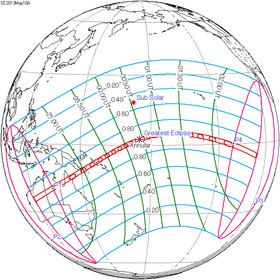Nature Annular Magnitude 0.9544 Max. width of band 173 km (107 mi) Date 10 May 2013 | Gamma -0.2694 Duration 363 sec (6 m 3 s) (P1) Partial begin 21:25:10 | |
 | ||
Other Instances Solar eclipse of April 8 - 2, Solar eclipse of July 2 - 20, Solar eclipse of August 2, Solar eclipse of March 9, Solar eclipse of March 20 | ||
Annular solar eclipse of may 10 2013 all you need to know
An annular solar eclipse took place on May 9–10 (UTC), 2013, with a magnitude of 0.9544. A solar eclipse occurs when the Moon passes between Earth and the Sun, thereby totally or partly obscuring the image of the Sun for a viewer on Earth. An annular solar eclipse occurs when the Moon's apparent diameter is smaller than the Sun's, blocking most of the Sun's light and causing the Sun to look like an annulus (ring). An annular eclipse appears as a partial eclipse over a region of the Earth thousands of kilometres wide.
Contents
- Annular solar eclipse of may 10 2013 all you need to know
- Visibility
- Solar eclipses 2011 2014
- Tritos series
- Metonic cycle
- References
Visibility
Annularity was visible from a 171 to 225 kilometre-wide track that traversed Australia, eastern Papua New Guinea, the Solomon Islands, and the Gilbert Islands, with the maximum of 6 minutes 3 seconds visible from the Pacific Ocean east of French Polynesia.
Solar eclipses 2011-2014
Each member in a semester series of solar eclipses repeats approximately every 177 days and 4 hours (a semester) at alternating nodes of the Moon's orbit. Note: Partial solar eclipses on January 4, 2011, and July 1, 2011, occur in the previous semester series.
Tritos series
This eclipse is a part of a tritos cycle, repeating at alternating nodes every 135 synodic months (≈ 3986.63 days, or 11 years minus 1 month). Their appearance and longitude are irregular due to a lack of synchronization with the anomalistic month (period of perigee), but groupings of 3 tritos cycles (≈ 33 years minus 3 months) come close (≈ 434.044 anomalistic months), so eclipses are similar in these groupings.
Metonic cycle
The metonic series repeats eclipses every 19 years (6939.69 days), lasting about 5 cycles. Eclipses occur in nearly the same calendar date. In addition the octon subseries repeats 1/5 of that or every 3.8 years (1387.94 days).
